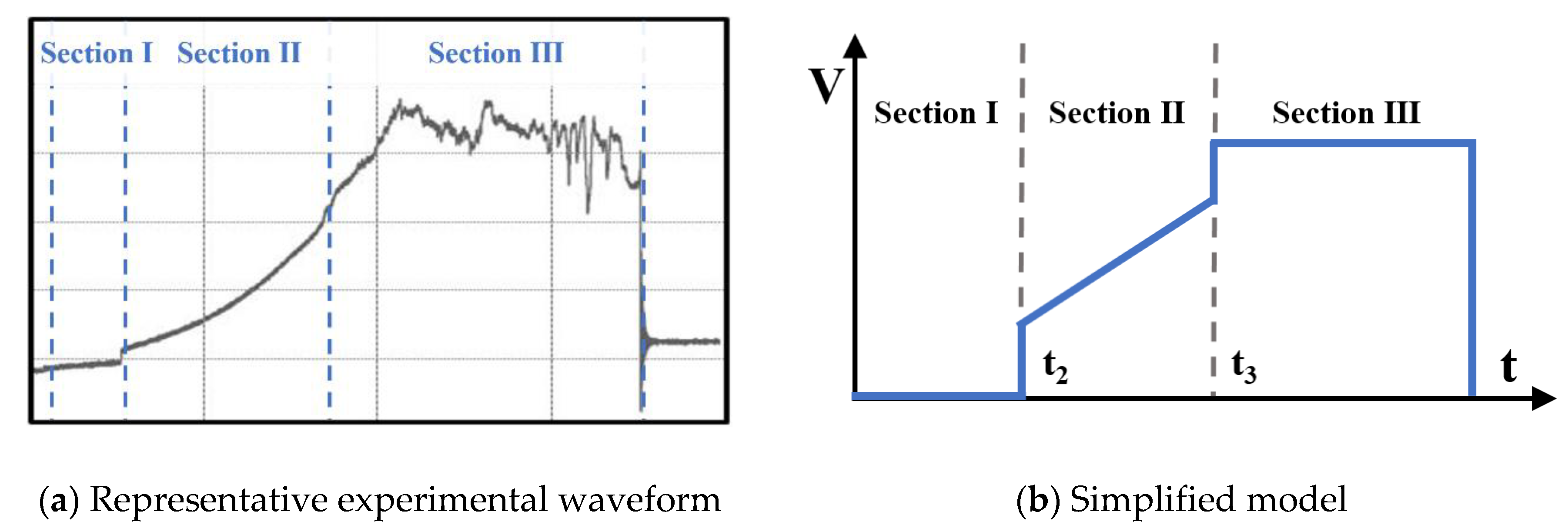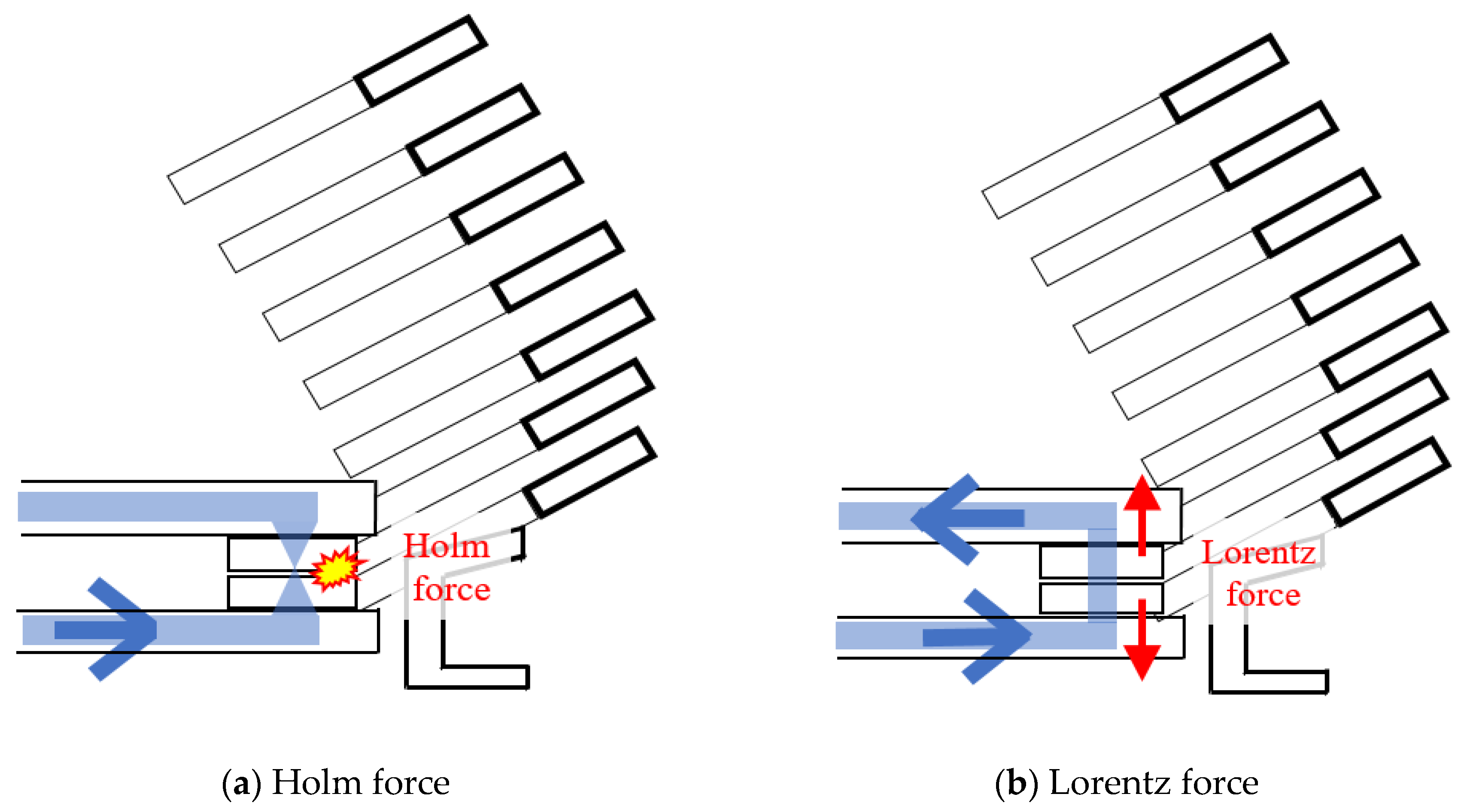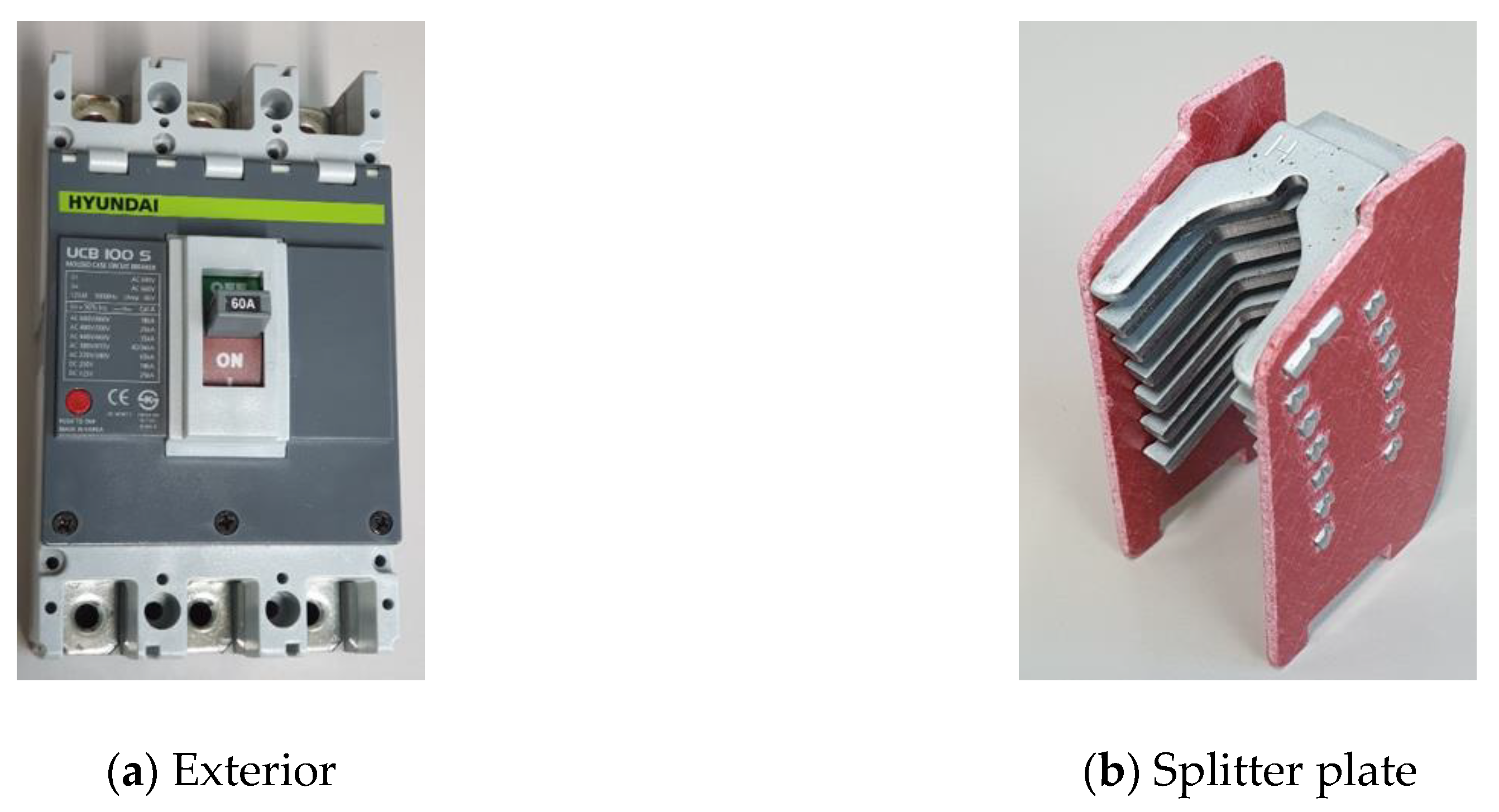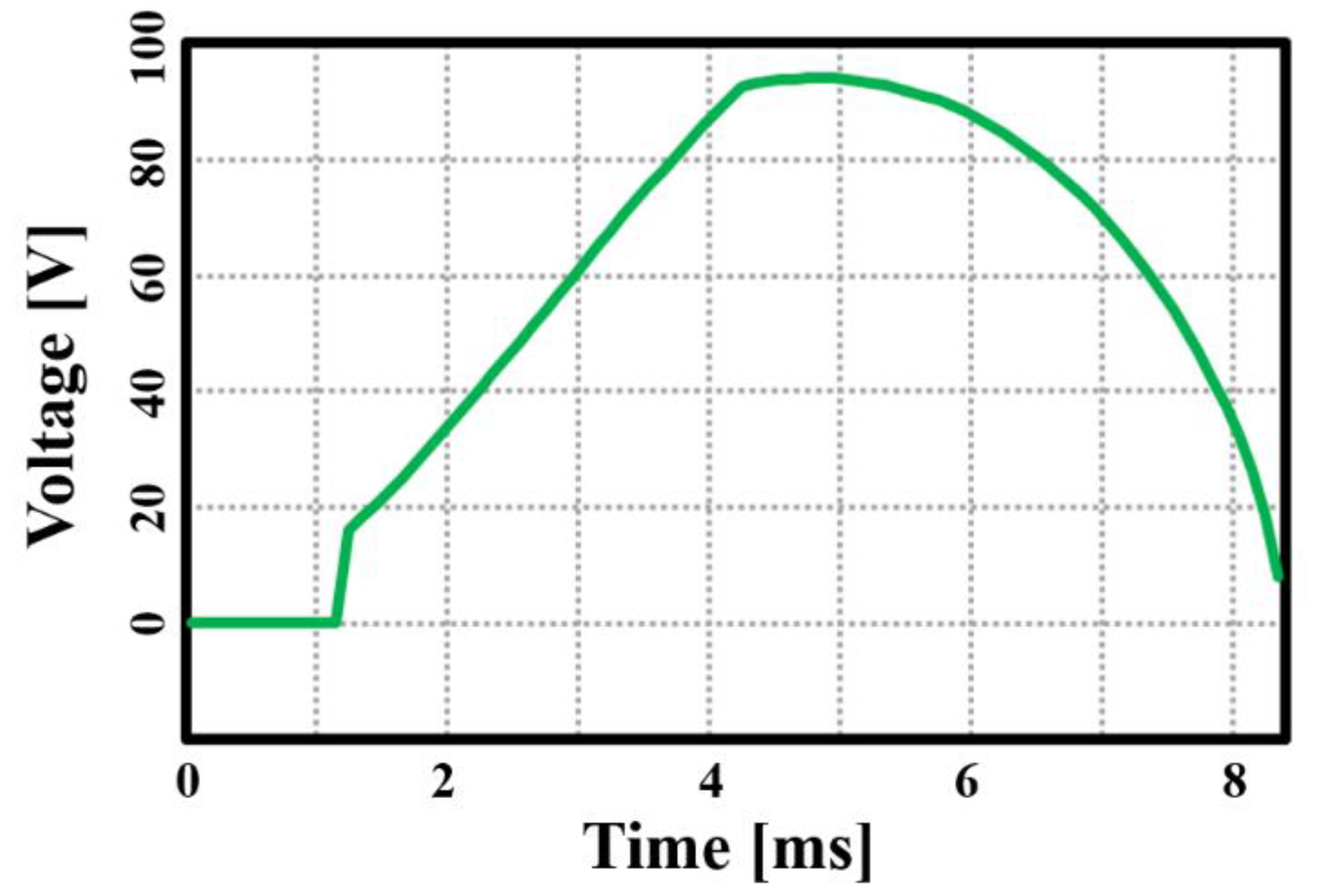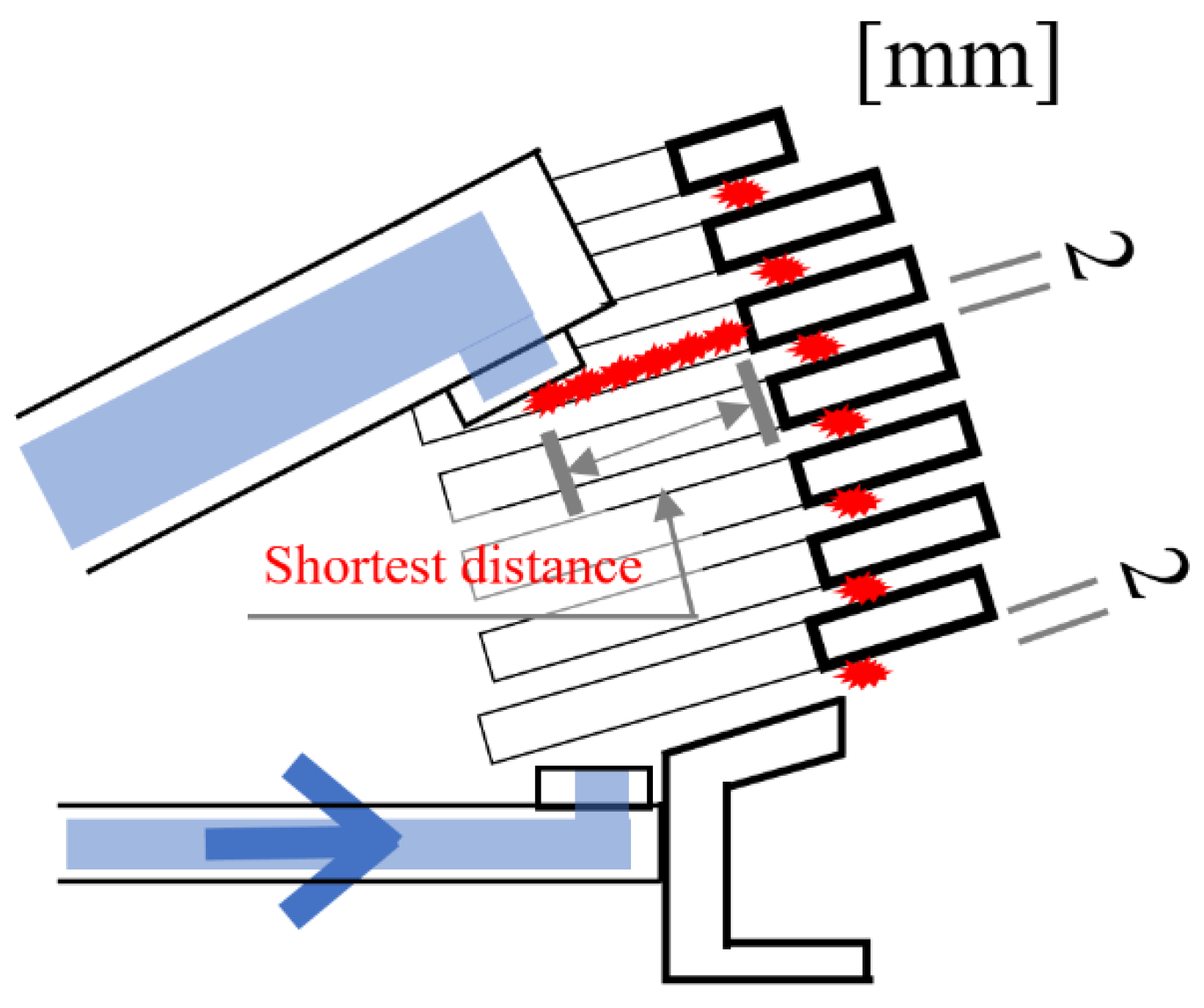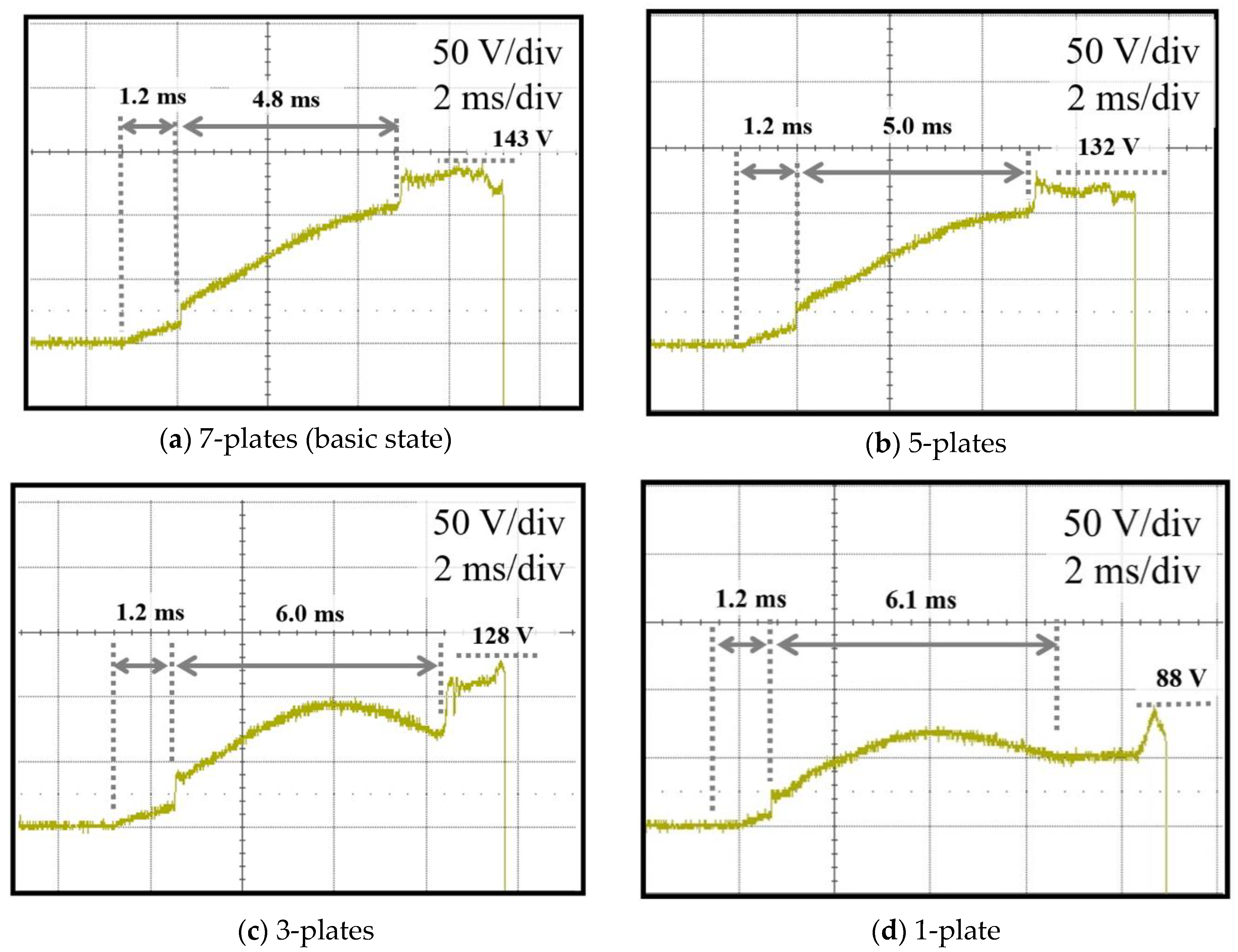1. Introduction
There are various types of circuit breakers installed to protect loads in the event of over-current inflow, depending on capacity and operation. Recently, research on circuit breakers, which are used in a DC power system, has been actively conducted [
1,
2,
3,
4]. Among them, the circuit breaker frequently used in the distribution system is the mold case circuit breaker (MCCB). The study in this field is mainly focused on the study of the characteristics of voltage current in the circuit breaker and its experimental study [
5,
6,
7,
8,
9]. In addition to interruption performance, research is being conducted on the characteristics after interruption [
10,
11,
12,
13,
14].
The trip movements of circuit breakers are classified as mechanical, thermoelectric, and so on depending on the breaking time according to the current flowing into the circuit breaker. The actual blocking performance of the circuit breaker is the extinguishment capability of the arc current between electrodes after tripping. The arc-extinguishment section of the circuit breaker is equipped with an arc runner, splitter plate, and so on to cancel the arc between the contacts. Among them, the splitter plate extends, cools, and divides the arc current.
The circuit breaker’s interruption consists of complex phenomena. When over-current inflows, bimetal operates the driving part so that the moving electrode is operated by mechanical force. At this time, it takes one to two seconds empirically to detect and actually operate the fault current, varying slightly from circuit breaker to circuit breaker. Then, the arc of high temperature between the contacts damages the moving and fixed electrodes and generates high-pressure hot gas. Then, the arc current moves towards the splitter plate by the pressure of the hot gas and by the complex electrical force. When the moved arc touches the splitter plate, as previously mentioned, the arc is extended, cooled, and divided. These phenomena are nonlinear, so it is somewhat difficult to analyze them individually.
In a typical circuit breaker, when the arc from the contacts reaches the splitter plate, it has a current limit effect that limits the increase in the amount of current introduced by arc voltage. As this effect is an important characteristic that affects the interruption performance of the circuit breaker, many studies are being conducted on the voltage-current characteristics in this area. In a structure with an arc-extinguishment chamber surrounded by molds, such as a wiring circuit breaker, the arc power density increases significantly; in particular, the average current density on the surface of the splitter plate can reach hundreds of A/mm
2 [
15,
16]. Various studies have been conducted on these arc currents [
17]. In particular, it was found that, the smaller the electrode size of the contacts, the higher the arc voltage [
18,
19]. Arc movement during contact separation is also an important factor in analyzing interruption. The reaction force at the contact electrode is proportional to the magnitude of the current, and it is confirmed that it reacts at about ten times the rated current. Therefore, the more the fault current flows into the wiring circuit breaker, the faster the current-time response.
In this paper, the interruption phenomenon of a circuit breaker is analyzed step-by-step. By circuit modeling each step, the complex phenomenon has been simplified. Thus, it is expected to reduce the time spent on interpretation and to derive factors to improve blocking performance. Moreover, the proposed MCCB model can be used for fault phenomenon applications, which have the advantage of integrating the entire system into a single circuit analysis. Research on modeling and analyzing interruption phenomena based on experiments has been carried out previously. Xingwen Li et al. conducted a study of the entire interruption process of the MCCB in accordance with the conditions of the mobile electrode [
8]. Fei Wang et al. compared arc behavior during the blocking process with experiments and simulations [
20]. Compared with other studies, this study is characterized by modeling the entire interruption process by zone and analyzing the factors that have a dominant influence on each zone. In addition, circuit modeling is used to simplify the system, reducing calculation time and enabling connection between systems. This is the difference from other studies. This study can be applied on the limited contacts (structure with splitter plates between contacts) among low voltage circuit breakers. This requires further research. This study can be used to conduct a structural improvement study.
The composition of this paper is as follows: (2) Interruption Phenomenon and Background Theory, (3) Circuit Modeling, (4) Circuit Model Simulation and Experiment Results, and (5) Conclusions. Chapter 2 briefly introduces the interruption phenomenon, and introduces the background theory needed for the area. In Chapter 3, circuit modeling is conducted on the basis of Chapter 2. Finally, Chapter 4 verifies the validity of this circuit model by comparing the experimental results with the derived circuit model.
2. Interruption Phenomenon and Background Theory
Figure 1 shows the waveform that occurs when the typical MCCB interrupts and the model that simplifies it. The interruption is largely divided into three parts: (1) section I: before contact opening; (2) section II: arc current growth; and (3) section III: arc extinguishment through splitter plate. In
Figure 1b, t
2 and t
3 are the starting times for section II and section III, respectively.
First, section I is the time until the trip is activated and the contact is opened in over-currunt occurrence. The forces acting upon opening are the mechanical forces of the basic MCCB drive and the electrodynamic reaction force [
21]. This electrodynamic repulsion force consists of Holm force and Lorentz force. The overall open force is as follows:
As a result of overcurrent, approximately 1 to 2 ms is required for the circuit breaker to detect and open contact. Assuming that the mechanical force of the MCCB drive unit is constant among the total forces applied to the contacts, it is the electrodynamic repulsion force that can affect the time of additional contact opening.
Figure 2 shows the electrodynamic repulsion force generated by the MCCB.
Holm force is as follows. Before the contacts are opened, the current is concentrated in a very small area between the contacts. This causes the concentration of current, and the generated magnetic flux density between contacts produces electromagnetic rebound forces.
Here, I is the current, in units (A); H is the hardness of the material; and A is the area of the contact, in units (m2). This force exerts its force when the contact is attached, and when the contact begins to fall, it is exponentially less powerful. The maximum value of this force may be affected by the opening of the contact point, but in most cases, the circuit breaker application is omitted owing to its weak force.
In the structure of the MCCB, the direction of current at fixed electrode and the direction of current at moving electrode are set in opposite directions. This generates a push force between the two electrodes, which is called the Lorentz force. Generally, the direction of rotation of the magnetic field is determined by the direction of the current. If the current direction of the two adjacent straight conductors is reversed, the direction of the magnetic fields produced is set in reverse. This strengthens the magnetic field between the two conductors, which forces the two conductors to move away. This occurs between the fixed and moving electrodes in this application. The following is the Lorenz force.
Here, le is the length of the electrode arm, in units (m); and de is the distance between the electrodes, in units (m). The application requires additional application of the angle changing in Equation (3). If the current flowing is large enough, the Lorentz force not only operates before the contact opens, but also can have an effect after the contact is opened.
Section II is the section where the contacts are opened, and arcs are generated and enlarged. This section is divided into the arc generating between the electrodes and the arc extending to the splitter plate. First, the former is as follows. The time of contact opening with the mechanical force of the MCCB drive is similar, although there is a small difference for each product. If the mechanical force provided by the product exists and the current is large enough, it can reduce the time when the contact is fully open. However, it is difficult to see the effect if the current is not large.
When an arc occurs, the arc temperature can be obtained from the energy balance equation as follows [
22,
23]:
Here, ε is emissivity, σsb is the Strfan=Boltzman constant (), As is the surface area of the arc, η is the percentage of electrical power that is converted into radiation, I is the arc current, and Vcolu is the arc voltage. η is assumed to be 70%.
When the arc between the electrodes is generated, the voltage of the arc column is obtained as follows [
23]:
Here, larc is length of arc; jroot is the average current density of arc root, in units (a/mm2); and a is the arc column expansion coefficient. This value is set to 1.
Next, we will infer the process of arc extending to the splitter plate as a rough progression of external forces acting on the arc. The main external force is the force caused by hot gas emissions from arc discharge [
20]. It can be interpreted through the following ideal gas law.
Here,
P is the pressure,
V is the volume, n is the mole constant,
R is the gas constant, and
T is the temperature. Basically, the moving electrode moves by drawing an arc comparing to the fixed electrode. This shows that the force is applied in the outer direction of the circle. Assuming that the number of moles does not change for approximate force size and direction, the temperature difference in space can be expressed as a pressure difference. This can indicate the direction and magnitude of the force.
Here, P1 is the pressure changed by the arc current, P0 is the ambient pressure, and A is the cross section of the space affected by the force. Based on the arc current, there is less space inside, and the outside is trapped by the splitter plate. Among these, the upper part of the splitter plate direction has a relatively large amount of space, and exhaust also exists in that direction. Because of this, the generated arc current extends upward towards the plate. The Lorentz force, which we have looked at earlier, can help the arc current extend further upward. Some circuit breakers are designed to induce movement of arc current by utilizing ferrite cores and other surrounding conductors such as splitter plates.
Section III is the process in which the extended arc current meets the splitter plate and consumes energy. The energy consumption, like section II, is classified as the energy consumed in arc current air and the energy consumed by the arc current touching the splitter plate. These two forms of energy consumption are expressed as voltages between electrodes in the circuit model proposed in this paper. The arc column voltage, the first energy consumption form, can be constructed by applying the extended arc current length to expression (6). The second energy consumption form can calculate the energy that the splitter plate has, for instance, the energy taken from the arc current, depending on the temperature of the splitter plate. Expression (10) shows the energy delivered by the arc current to the splitter plate for a certain period of time.
Here,
c is the specific heat, in units (J/gK);
M is the weight of matter, in units (g); and
Tarc is the arc temperature, in units (K). The voltage drop of the plate is obtained as follows:
4. Comparison of Simulation Model and Experimental Results
Figure 13 shows the simulation result using the proposed circuit model. It is simulated using PSIM. The details of the resulting values are covered in the comparison section of the experimental results.
To verify the proposed circuit model, we conduct an experiment on the aforementioned cases.
Figure 14 shows the experimental setup. The experimental power supplies an overcurrent for the MCCB to operate the interruption. This overcurrent is determined by the capacitor’s charging voltage, capacitance, inductance, and so on. In this paper, the charging voltage is set to 640 V, capacitance is set to 26,700 μF, and inductance is set to 0.258 mH. These values are to allow the incoming over-current frequency to have a value of 60 Hz, with half-wave (8.3 ms) of its entire cycle as the current is zero. The experimental waveforms for cases are presented in
Figure 15.
Table 2 below compares the simulated voltage waveform with the experimental voltage waveform. In section II, the mean value of the voltage is calculated, and in section III, the peak value of the voltage is calculated because it is assumed to be a constant voltage. Looking at the results, in section II, 1-plate cases show the largest error rate (36.5%) and, in section III, 3-plates cases show the largest error rate (−25.0%). Overall, the largest error rate is in the case of 1-plate, with the largest number of plates removed compared with the basic state. In the experimental waveform of the 1-plate case (
Figure 15d), the beginning of section III shows a constant voltage and then the voltage rises unlike other experimental waves. This is not consistent with the simplified model (
Figure 1b) proposed by this paper. In addition, 7-plates to 3-plates can be interpreted as arc movement in the upward moving electrode, but 1-plates do not show that much time difference. It is predicted that this is not moving from top electrode, but from bottom electrode through the arc runner. It is important where the arc first touches the splitter plate moved by the force, that is, the top or bottom electrode.
Figure 16 shows the damaged state of plates and supports after several interruption experiments on the splitter plate. The damaged area is marked with white dotted lines. The pictures of the plates show that the second and third plates are the most damaged. This shows that almost all areas of the second plate are charred, and the third plate is slightly dug (white dotted circle). This feature can also be seen in the support fixture in
Figure 16b. Most of the damage occurred in the space around the second and third plate above. In addition, this shows that there is a lot of discharge between the seventh (bottom) plate and the arc runner (white dotted circle).
